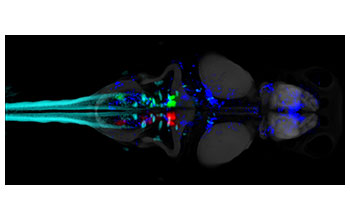Multimedia Gallery
How animals find their way in the dark
Mapping neurons that control spontaneous swimming behavior across the zebrafish brain. Gray and cyan are anatomical markers, with cyan showing neurons that project to the spinal cord. The green, red, and blue cells result from functional mapping, where green cells control leftward turning, the red cells control rightward turning, and the blue cells are tuned to forward swimming. These populations of neurons guide spontaneous zebrafish behavior when external environmental cues are lacking.
More about this image
Research by scientists at Harvard University has revealed the brain activity in animals that helps them find food and other vital resources in unfamiliar environments where there are no cues, such as lights and sounds, to guide them.
Researchers used whole-brain imaging in larval zebrafish to discover how their brain activity translates into spontaneous behaviors. They found that the animals' behavior in plain surroundings is not random at all, but is characterized by alternating left and right turn "states" in the brain, where the animals are more likely to perform repeated left and right turning maneuvers, respectively.
"We noted that a turn made by the zebrafish was likely to follow in the same direction as the preceding turn, creating alternating "chains" of turns biased to one side and generating conspicuous, slaloming swim trajectories," says first author Timothy Dunn, a postdoctoral researcher at Harvard.
"Freely swimming fish spontaneously chained together turns in the same direction for approximately five to 10 seconds on average, and sometimes for much longer periods. This significantly deviates from a random walk, where movements follow no discernible pattern or trend."
By analyzing the relationship between spontaneous brain activity and spontaneous behavior in the larval zebrafish, the researchers generated whole-brain activity maps of neuronal structures that correlated with the patterns in the animals' movements.
They discovered a nucleus in the zebrafish hindbrain, which participates in a simple but potentially vital behavioral algorithm that may optimize foraging when there is little information about the environment available to the animal.
As such behavioral strategies must exist in other animals that explore environments much larger than themselves, the team expects that the neural systems observed in the zebrafish must also exist in other organisms.
To learn more about this research, see the Eurekalert news story Scientists reveal how animals find their way 'in the dark. (Date image taken: 2016; date originally posted to NSF Multimedia Gallery: Jan.10, 2017)
Credit: Dunn, Yu, Narayan, Randlett, Naumann, Yang, Schier, Freeman, Engert and Ahrens
Images and other media in the National Science Foundation Multimedia Gallery are available for use in print and electronic material by NSF employees, members of the media, university staff, teachers and the general public. All media in the gallery are intended for personal, educational and nonprofit/non-commercial use only.
Images credited to the National Science Foundation, a federal agency, are in the public domain. The images were created by employees of the United States Government as part of their official duties or prepared by contractors as "works for hire" for NSF. You may freely use NSF-credited images and, at your discretion, credit NSF with a "Courtesy: National Science Foundation" notation.
Additional information about general usage can be found in Conditions.
Also Available:
Download the high-resolution JPG version of the image. (282.9 KB)
Use your mouse to right-click (Mac users may need to Ctrl-click) the link above and choose the option that will save the file or target to your computer.

